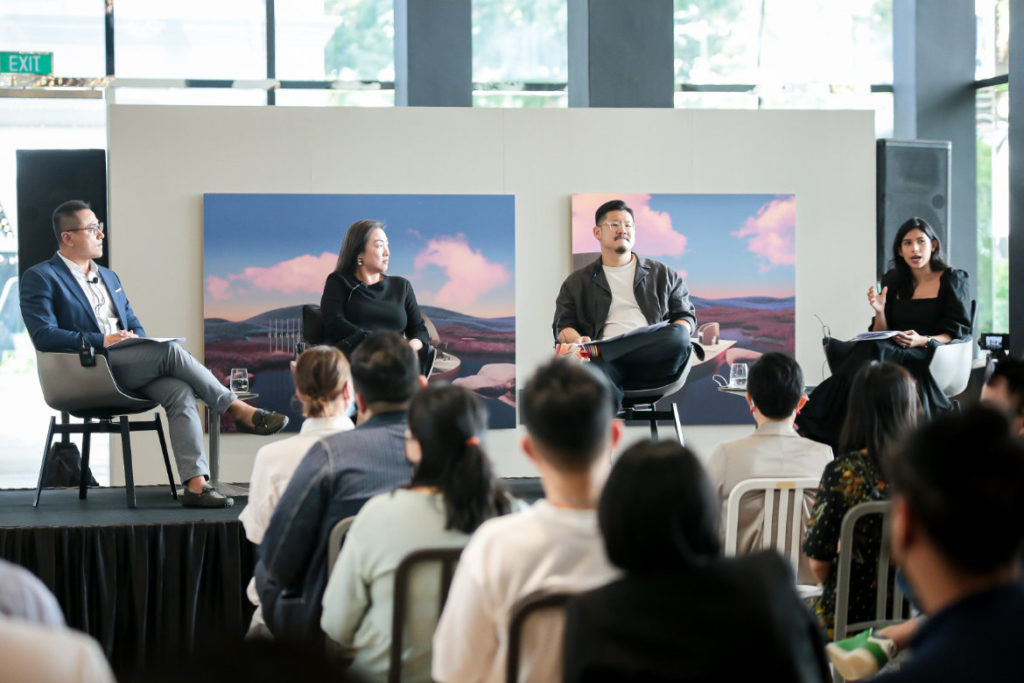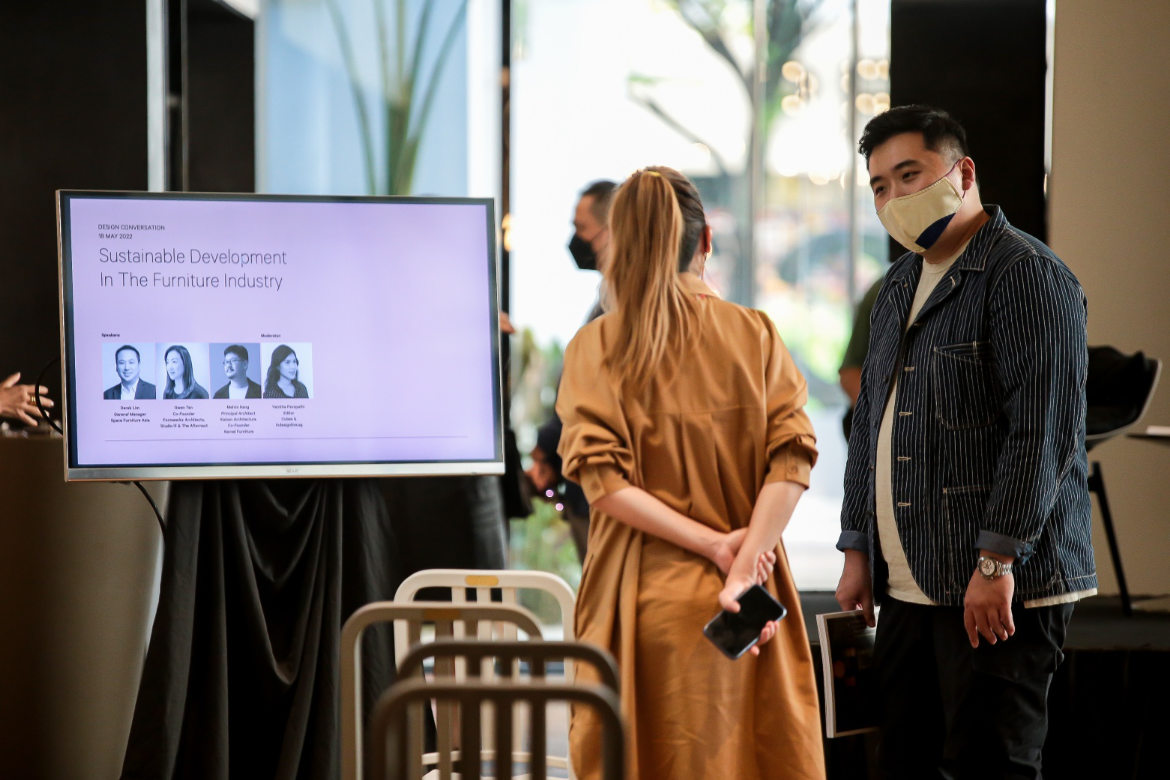What can be done to reduce the environmental impact of the furniture industry? Three industry professionals share their thoughts, initiatives, and aspirations for a greener industry..

May 25th, 2022
Many industries have embraced environmental stewardship and the furniture industry is no exception. But what makes a piece of furniture sustainable? Is responsibly sourced material enough to warrant its sustainability?
At Space Furniture x Indesign’s Design Conversation last week, Vanitha Pavapathi, Editor of Cubes magazine and Indesignlive.sg put these questions to a panel of speakers with backgrounds in retail, architecture and industrial design. As the furniture industry has dynamically evolved over the last 20 years with consumers becoming more discerning and receptive to change, the panel agreed that designers and retailers have had to be innovative and transparent in their material choices, production processes and business practices.

“In 2021, Space Furniture engaged an environmental agency to help the company become carbon neutral and adopt a circular design methodology,” says Derek Lim, General Manager of Space Furniture Asia. “We are reviewing and measuring our carbon footprint, energy consumption and materials across supply chains. It’s a journey that begins with a full transport audit and the collection of product data across materials and brands.”
Space Furniture’s green initiative is commendable but it shouldn’t be limited to select businesses. Gwen Tan, Co-Founder of Formwerkz Architects, Studio iF and The Afternaut states that the industry as a whole should take a stand to be more transparent. “Blockchain can give clearer information and prove to consumers that it is not just a marketing ploy to charge more for sustainable furniture. Hopefully this will happen in the near future where consumers would know the type of materials used, the carbon footprint to produce it, the company’s way of off-setting their carbon footprint, parts that are replaceable, green alternatives, and et cetera.”

While the idea is promising and could potentially be a game-changer for the industry, the key to sustainability according to Melvin Keng, Principal Architect of Kaizen Architecture and Co-Founder of Kernel Furniture, is to not overproduce and overconsume. “The fact that Kernel Furniture produces made-to-order pieces, there’s no excess carbon footprint,” says Keng.
Lim offered similar observations about rethinking the value and meaning of furniture. “Like our partners and friends across the design industry, a founding principle of Space Furniture’s philosophy is to support design that is built on quality, function, beauty, and importantly product longevity, to fundamentally shift the overconsumption model and discourage the throwaway culture.”

To that regard, Tan and Keng look at what can be repurposed or salvaged in their architectural and interior projects. As much as they would like for furniture to be repaired before they’re repurposed, Keng shares that costly labour in Singapore is the biggest hindrance. With the advancement of technology, he says, it may be possible for machines and robotics to take over repair work in the future. “With less reliance on human labour and improved efficiency, the cost of repair is bound to decrease.”
Tan agrees and implores businesses to design furniture with a clear purpose and make them repairable. “Furniture makers could explore 3D-printing joineries so we don’t exploit resources for the purpose of keeping and storing parts that we don’t need.” When it comes to ad-hoc projects and design installations that typically generate waste, Tan and Keng use them as opportunities to educate the industry and public on sustainability. “Sustainability is not about the material but the way we use it,” says Tan. “In 2014, we collaborated with EDL to present ‘The Tree’, a five-metre-high Christmas tree installation as a solution to upsell laminate off-cuts and to create awareness on the impact of Christmas tree farming.






For Lim, sustainable development relies on cross collaboration and knowledge sharing. “The push for greater adoption of a circular economy requires designers and businesses to support one another in this shared global responsibility.” Tan concludes that we also need to explore alternative materials and capitalise upon emerging technologies to ensure a resilient furniture industry.


A searchable and comprehensive guide for specifying leading products and their suppliers
Keep up to date with the latest and greatest from our industry BFF's!

The Man x Machine x Material collaboration by Jarrod Lim and The American Hardwood Export Council explores how generative AI can enhance design processes while also revealing the areas where human intuition remains irreplaceable.

XTRA celebrates the distinctive and unexpected work of Magis in their Singapore showroom.

BLANCO launches their latest finish for a sleek kitchen feel.

With the exceptional 200 Series Fridge Freezer, Gaggenau once again transforms the simple, everyday act of food preservation into an extraordinary, creative and sensory experience, turning the kitchen space into an inspiring culinary atelier.

Italian furniture brand Pedrali is known for leading the way when it comes to the workplace. We speak with Busetti Garuti Redaelli design studio about the evolution of the Buddy collection – a solution for hybrid spaces that can support all sorts of working styles.

Knoll’s revolutionary legacy, from its pioneering mid-century modern origins to its current place within the MillerKnoll collective, continues to shape the spaces we inhabit. Here, we explore the iconic institutions, influential collaborations, and groundbreaking ideas that have shaped Knoll’s unique understanding of the human-space connection — the bedrock of the brand’s enduring relevance.
The internet never sleeps! Here's the stuff you might have missed

A new holistic workplace design typology is achieved thanks to collaboration and customisation.

This insightful interview reveals how CCD Singapore plans to lead the luxury design industry through design innovation and adoption of AI technology in creating unique user experience.

This chair makes flexible working easier than ever, thanks to intelligent engineering and human centred design.

Designing people-first buildings with flooring that contributes to achieving WELL features in the WELL Building Standard. Works with WELL is a new trademark created by the International WELL Building Institute for use by manufacturers to show when their products align with features in the WELL Building Standard.